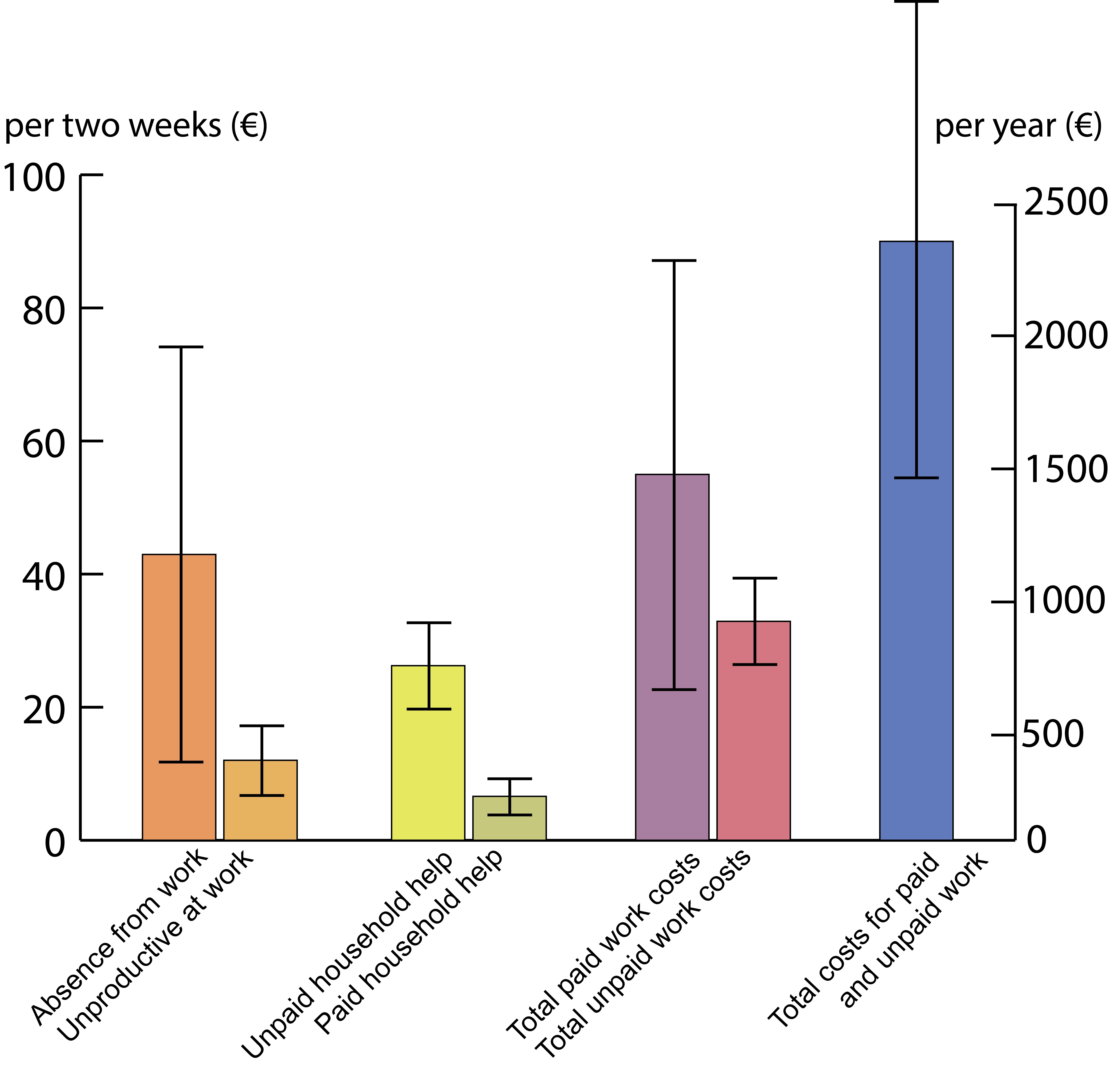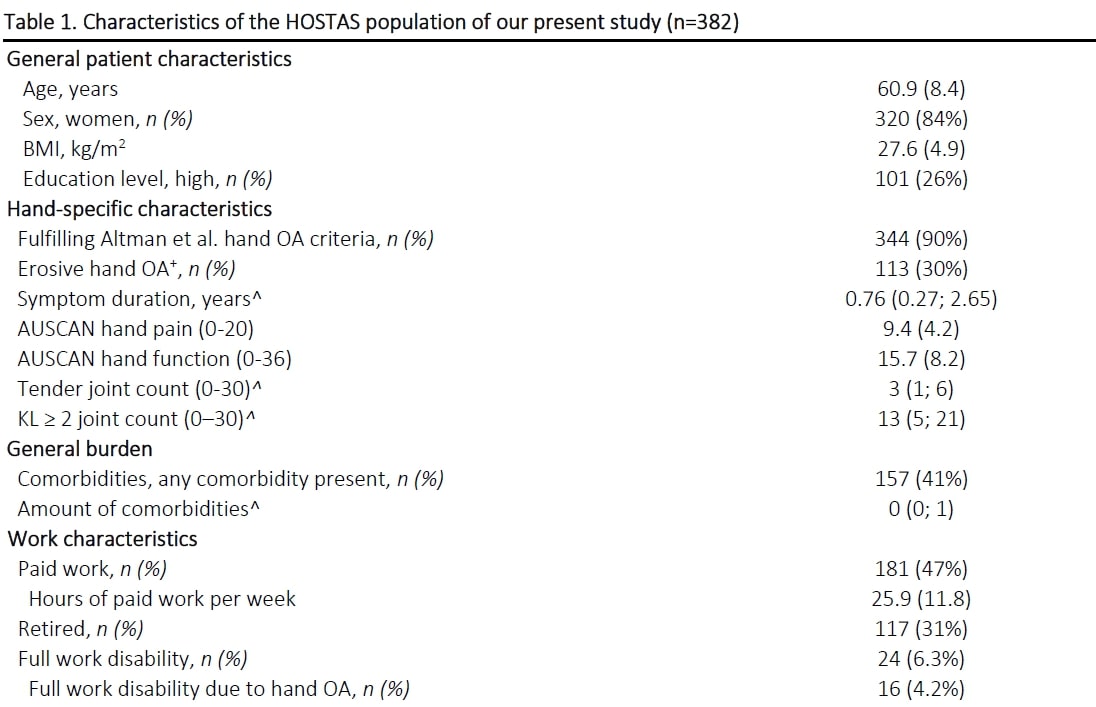Session Information
Session Type: Poster Session C
Session Time: 8:30AM-10:30AM
Background/Purpose: Rheumatic musculoskeletal diseases (RMDs) can cause impairment at paid and unpaid work and contributes to societal burden and costs. However, data on this topic concerning hand osteoarthritis (OA) is scarce.
Therefore, we aimed to investigate the association of hand OA with paid and unpaid work participation, as well as socio-demographic and disease characteristics related to productivity loss and societal costs.
Methods: We used data of the Hand OSTeoArthritis in Secondary care (HOSTAS) cohort. A diagnosis of hand OA by the treating rheumatologist was the case definition. Patient and OA characteristics were assessed by validated standardized questionnaires and tests. The Health and Labour Questionnaire (HLQ) was assessed on the last two weeks and related to hand OA for paid work hinder score (6 – 24), production loss while at work and hours of sick leave, as well as unpaid work replacement and hinder score (4 – 16). Self-reported income was collected to estimate income inequality compared to the Dutch age-gender-education matched population without hand OA
Societal costs (€) of paid work were estimated by multiplying number of hours of production lost due to hand OA (while present or absent form work) by the average hourly societal costs of paid work in The Netherlands. Societal costs of unpaid work were estimated by multiplying the hours of unpaid work replaced by others by the Dutch gross average hourly salary of a household help. Costs were adjusted to 2019 values using consumer price indices. Costs per two weeks were extrapolated to costs per year by a using a conversion factor (26.09).
Results: HLQ data was available for 382 patients (mean age 60.9, 86% women, mean BMI 27.6 and 41% having any comorbidity, table 1). Of these persons, 16 (4%) had full work disability due to hand OA, 117 (30%) were retired and 181 (47%) had paid work. Thirteen employed persons (7.2%) reported sick leave due to hand OA, in which case a median of 42 work hours (IQR 24; 54) were lost in the past two weeks (table 2). Hinder at work was reported by 120 out of 181 working patients (66%), with a hinder score of 7 (6; 8). Unproductive hours while at work were reported by 28 (15%) patients, with a median of 4 hours (2; 6) in those experiencing unproductive time. Unpaid work hinder score was 8 (7; 10). Replacement of unpaid work was necessary in 180 patients (47%), with a median of 3 hours (2;7) per patient requiring help replaced.
Mean total societal costs per hand OA patient in the cohort (n=382) were estimated €90.00 (95% CI 55.20; 124.81), translating to 2343 euros (1964; 5724) per year (figure 1). Furthermore, patients showed a lower yearly and hourly income than a matched general Dutch population aged 55 to 65.
Conclusion: Hand OA is associated with significant hinder in paid and unpaid work participation, which translates in substantial societal costs of lost productivity. Future research should investigate prevention of hand OA sickness, absence and unproductiveness, as well as interventions to adapt the work environment to the hand OA patient.
 Figure 1. Mean societal costs associated with hand OA per patient in our total cohort, with 95% confidence interval.
Figure 1. Mean societal costs associated with hand OA per patient in our total cohort, with 95% confidence interval.
To cite this abstract in AMA style:
Terpstra S, van de Stadt L, Boonen A, Rosendaal F, Kloppenburg M. The Association of Hand OA with Paid an Unpaid Work Impairment and Related Costs: The Hand Osteoarthritis in Secondary Care Cohort [abstract]. Arthritis Rheumatol. 2021; 73 (suppl 9). https://acrabstracts.org/abstract/the-association-of-hand-oa-with-paid-an-unpaid-work-impairment-and-related-costs-the-hand-osteoarthritis-in-secondary-care-cohort/. Accessed .« Back to ACR Convergence 2021
ACR Meeting Abstracts - https://acrabstracts.org/abstract/the-association-of-hand-oa-with-paid-an-unpaid-work-impairment-and-related-costs-the-hand-osteoarthritis-in-secondary-care-cohort/


